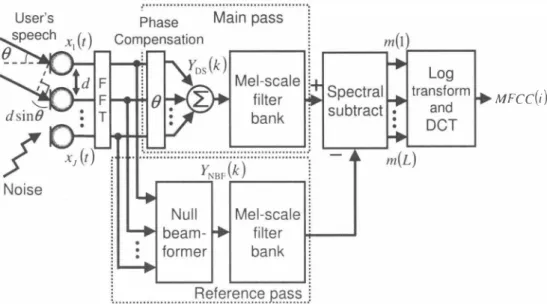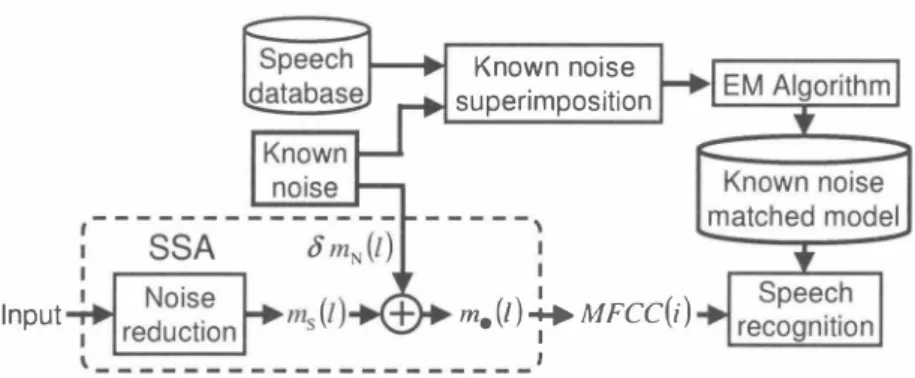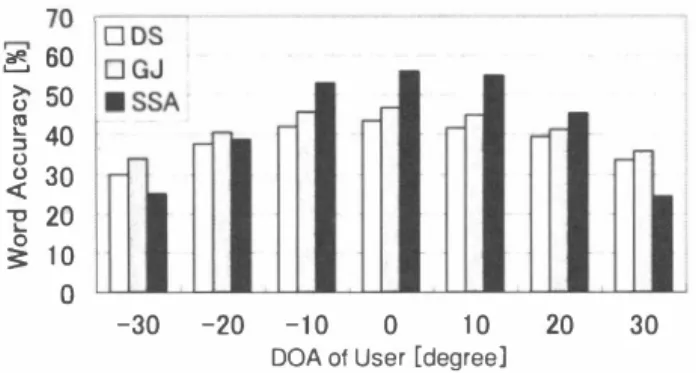Noise-Robust Hands-free Speech Recognition Based on Spatial Subtraction Array and Known Noise Superimposition
全文
(2) MFCC(i). Fig. 1.. Speech enhancement procedure in the proposed SSA. power spectrum takes a negative value, m(l) is obtained by using ftooring processing whereγis the ftooring co巴fficient Because a common speech recognition is not so sensi tive against phase information, the proposed SSA which is performing subtraction processing in power-domain is mor巴 applicable for the speech recognition. GJ requires the adaptive learning of FIR-filters of lhousands or millions of taps. On the other hand, in general, the ord巴r of the filter bank 1 is set to 2 4, and consequently the proposed method optimizes only 24 parameters. Moreover, the proposed method is performed in the mel-scale filter bank domain and th巴 transform into MFCC as follows:. They satisfy the relation among adjacent windows as. kc(l). =. k1li(1. - 1). = k1o(1 + 1).. (2). Moreover, れ(1) is arranged in regular intervals on mel frequency domain. Mel-scale frequency ]\f e1k,(l) for れ(1) is calculated as. 1. M e k, (1) = 2595. 叶. (3). where fs is the sampling frequency and ]If is the DFT size. B. Noise Reduction Processing. In the proposed method, noise reduction is canied out by subtracting the estimated noise power spectrum from the enhanced target spe巴ch power spectrum in the mel-scale filter bank domain as. λ山C(i). =. Ii土山. where i denotes the dim巴nsion of MFCC. The proposed. m(l) =. SSA doesn't require the transformalion into the time-domain. 乞 W(k; 1){lYos(kW. waveform. Therefore the amount of caJculation of SSA is sign.ificantly reduced compared with that of GJ.. α(1)β|YNBF(k)|2H(4). k=kt" (1). (if. m(l) =. IYos(k)12. III.. α(1)・3・IYN8F(k)12 > 0) (5). 乞 W(k; l){γlYos(k)l} (0伽wise ). K NOWN NOISE SUPERIMPOSITION. [12]. In the pr巴vious section, we d巴sClibe noise reduction pro cedures which utilized in SSA. There still, how巴ver, eXlsts a residual component of the original noise spectrum and spectral distortion in the noise reduced signal. In ord巴r to achieve an optimum recognition performanc巴 appropriately, we generally need to create matched acoustic models. How ever, since there are many different types of noise, then it would be impractical to creat巴 matched models for each of these noise. To solve this problem, we propose a superimpo sition of a known noise in mel-scale filter bank domain and introduce only one acoustic model matched with the known noise. Figure 2 shows a configuration of this procedure.. , (6). k=k1o (1). where rn(l) is the output from the mel叩ale filt巴r bank, is the outpUI signal from DS, iムthe parlly enhanced speech時nal, and YN8F(k) is the output signal from NBF in which the directional null st巴巴rs in DOA of the us巴r, i.e. , the estimated noise signal. The system switches in two equations depending on the conditions in (4) and (6). m(l) is a function of the subtraction coefficient ß and th巴 paramelerα(1) which is determined during a speech break. On the other hand, if the. Yos(k). 534. nku nHd -ーム.
(3) Known noise superímposítíon. SSA Input. Fig. 2.. (口こここj. δmM(l)l -. ) mo(l)斗MFCC(i) i. Procedure of known noise superimposition and using known noise matched acoustic model with SSA. 5.75. First, we superimpose known noise to speech database and make the co汀esponding matchcd model trained by EM algorithm in advance. Secondly, we superimpose known noise to the noise reduced output from mel-scale filter bank in SSA. The superimposition coefficient ð is calculated as ð=. 1 10SNR/I0. (乞L|ms(l)|2) (lごと1 ImN(I)l2) ,. +叩3羽O。露、1川1叩5 4.22. (8). =. Tì凡s(l) + ðmN(I).. :. Fig. 3.. O. Layout of reverberant room used in experiments. (9). Finally, we perform sp田ch recognition using krtown nois巴 matched model for the output of SSA. IV. E XPE RIMENTS. (窃窃司:5? ;λご「勺為ト 記£. m. 一→3O SNR : 5 dB Reverberation time : 200 ms Number 01 microphones : 4, 8. where SN R denotes the amount of noise superimposition, T町(1) is the output of speech from mel叩ale filter bank, and mN(I) is the known noise processed with mel剖ale filter bank analysis. The superimposed output mo(l) is given as. T句(1). m. AND RESU LTS. A. Experimental Setup. Figure 3 shows a layout of the reverberant room used in the experiment, and Table 1 shows the experimental conditions. In this experiment, we use the following signals as testing data the original speech convoluted with the impulse responses which are recorded in the real environment, and added with PC noise which is included in the real environment with an average of 5 dB at the array input In the proposed SSA, phase compensation of the main pass is done co汀巴sponding to the user's direction which is in front of the microphone array (00), and we use NBF of the reference pass in which the null st巴er巴d toward 00 and unit gain steered toward土900 with 2 elem巴nts. Noise reduction coefficients are decided by the results of speech recognition under the c1ean model conditions. The matched model is created by adding known noise to speech database with 2 5 dB signaトto-noise ratio (SNR). Known noise obtained in office room is different from PC noise in Fig. 3 and office room noise is comparatively stationary signal whose bias of spectrum is low, so this is suitable to mask various residuals of noise. The amount of superimposition is decided by the results of spe巴ch recognition with known noise 25 dB. matched model. In the conventional method, we superimposed known noise in time domain. In the experiments on robustness against user's mov巴ment, we use the speech data where the target user moves between ::1:300 around the microphone a汀ay. B. Results oJ Word Accuracy. First we compare DS, GJ, and the proposed SSA on the basis of word accuracy scores. Figure 4 shows the experimen tal results, wh巴re the user' position is fixed in front of the microphon巴 array.“Unprocessed" refers to the result without noise reduction processing using only one microphone. From these results, the word accuracy of the proposed SSA remarkably overtakes those of the conv巴ntional methods in both 4-microphone and 8-microphon巴 conditions. This is mainly due to【he differences in subtracting the noise, i. e., GJ performs the noise subtraction in terms of both amplitude and phase spectra. On the other hand, since SSA works in power-spectrum domain, it becomes robust for estimation of the paramet巴rs C. Effect oJ Using Known Noise Superimposition. Figur巴5 shows the experimental results using known noise superimposition and known noise matched model“1microphone" ref,巴rs to the result performing known noise superimposition with 30 dB and using known noise 2 5 dB matched model for one microphone.. 535. - 199-.
(4) TAB LE I. EXPERIMENTAL CONDITIONS. Database Task Acoustic model Number of training speakers Number of testing speakers Decoder Samp1ing frequency Frame size Fi1ter size Noise reduction coefficients Known noise Amount of superimposition. JNAS [9],306 speakers ( 15 0 sentences / 1 speaker) 20-k newspaper dictation phonetic tied mixture (PTM) r 10] (clean mode1, known noise 25 dB matched model) 260 speakers ( 150 sentences / 1 speaker) 46 speakers (200 sentences) JULIUS ver.3.4.2 r 1 1] 1 6 kHz 20 ms (400 samp1e) 32 ms (5 12 tap) β1.8 "(0.2 (4-microphone), ß: 1.9 "(0.3 (8-microphone) office room noise 30 dB (4-microphone), 35 dB (8-microphone). 70 r | 口 4-microphone 門60 I � ・ 8-microphone >- 50 U 40 2 0 � 30 320 3: 1 0. From th巴se results, we can see that this melhod is effective in whole, and can mask the residual of noise. In the proposed SSA, word accuracy is about5% higher than the resulls in the previous section. Thus th巴 effectiveness of superimposing known noise in mel-scale filt巴r bank can be asserted. D. Robustness against User's Movement. Unprocessed Fig. 4.. SSA. ・ 8-microphone. G. ,d. E仔'ect. C凶 nu. m. In this pap巴r, we proposed an SSA and known noise super imposition to realize a robust hands-free speech recognition under noisy environments. In the proposed SSA, since the noise reduction of lhe proposed m巴thod is performed in the mel-scale白Iter bank domain, the amounts of calculation of SSA is remarkably reduced. Moreover, in the proposed known noise superimposition, the r巴sidual noise and spectral distor tion included output in SSA be homog巴nized in particular noise, and output can match against the acoustic model. The experimental results obtained under the real environ ment reveal that the word accuracy of th巴 proposed method is greater than those of DS and 01 even when target user moves between土100 around the microphone array.. GJ. 口4-microphone. Fig. 5.. CONC LUSIONS. DS. Results of word accuracy in each method. nv ln nv h》 VE C. nunU 内Unununu nunu 守FDDFDaaTqd内441 O〉〉 コuu《万』 ポ]hO国」 [. V.. 。. e n. Figures 6 and 7 show lhe results of the word accuracy for different DOAs of user. In this experiment, we use 4 or 8 microphones and the same parameters of 01 and SSA which were estlmat巴d in the experiments of the previous section. From these resu1ts, the word accuracy of SSA is superior to those of the conventional methods in the case that DOAs of user are within 土100• Th巴refore lhe proposed SSA is more applicab1e compared to the conventional approaches However, the results of word accuracy in the case of that when a user moves over土200 is almost the same or lower than the conventional method. We speculale thal since the 1eakage of the speech signal is included in the reference pass owing 10 the user's movement, SSA perfo口ns subtraction not only noise signals but also speech signals, which leads to the ravaged speech components. This result indicates thal the DOA estimator is required if we confronted with the 1arge movement of user. Th巴 combination of DOA estimation processing still remains as an open prob1em for future study.. SSA. of using known noise superimposition. R EFERENCES [1 J B . H. Juang and F. K. Soong,“Hands-free telecommunications," Proc Internatiollal COllferellce 011 Hands-Free Speech COllllllllllication, pp.510, 2001 [2J R. Nishimura, T. Uchida, A. Lee, H. Saruwatari. K. Shikano, and Y Matsumoto,“ASKA: Receptionist robot with speech dialogue system," Proc. IROS-2002, pp.13 14-1317, 2002 [3] R. Prasad, H. Saruwatari, and K. Shikano, " Robots that can hear, understand and talk," Advanced Robotics, vol.l8, pp.533-564, 2004 [4J G. W. Elko, "Microphone aπay systems for hands-free telecommunica tion," Speech COllllllllnication, vo1.20, pp.229-240, 1996 [5 ] J. L. Flanagan, J. D. Johnston, R. Zahn, and G. W. Elko,“Computer steered microphone aπays for sound transduction in large rooms," J. Acollst. Soc. AlIlerica, vo1.78, nO.5, pp.1508-1518, 1985. 536. ハU nU 円/“.
(5) 70 I 垣60 I ロ GJ � 50 ! ・SSA 240 .!i. 30 "E 20 妥10 - - I 口DS. o. 。. -30. Fig.6. -20 -10. DOA 01. 0. 10. User [degree]. 20. 30. Robustness againsl user's movemenl (4・microphone). nununU《Ununununu マ'auk-uaaT句。内441 コuu〈2 0〉〉 国』 ho ま] [. -30. Fig. 7.. -20 -10. DOA 01. 0. 10. User [degree]. 20. 30. Robustness against user's movement (8・microphone). H. Saruwalari, S. Kurita, K. Takeda, F. Itakura, T. Nishikawa, and K. shikano, '‘B lind source separation combining independenl componenl analysis and beamforming," EURASIP J. Applied Signal Proc., vol.2oo3, no.ll, pp.1135-1 146, 2003 [7] L. J. Griftith, and C. W. Jim, “An alternalive approach 10 linearly constrained adaplive beamforming," IEEE Trans. Anlennas Propaga/ion, vol.30, nO.1 ‘ pp . 27-34, 1982 [8] S. B . Davis, and P. Mermelslein, "Comparisor】 of parametric repre sentalions for monosyUabic word recognilion in continuously spoken sentences," IEEE Trans. ACOllS/ics, Speech, Signal Proc.. voI.ASSP-28, no.4, pp.357-366, 1982 [9] K. Itou, M. Yamamolo, K. Takeda, T .Takezawa, T. Matsuoka, T. Kobayashi, K. Shikano, and S. Itahashi, “JNAS Japanese speech co巾us for large vocabulary continuous speech recognilion research," J Acolls/. Soc. Jpn (EJ, vo1.20, no.3, pp.199-206, 1999 [IOJ A. Lee, T. Kawahara, K. Takeda, K. Shikano,“A new phonelic tied mixture model for efficient decoding," Proc. ICASSP, vol.ill, pp.12691 272, 2000 [11] A. Lee, T. Kawahara, K. Shikano, "Julius - An open source real-time large vocabulary recognition engine," Proc. EUROSPEECH‘pp.1691[6]. 1694,2001 [12]. S. Yamade司 A. Lee, H. Saruwatari, and K. Shikano, “Unsupervised speaker adaptation based on HMM sufticient slalislics in various noisy environmenls," Proc. EUROSPEECH, pp.II-1493-1496, 2003. 537. 句14 ハU つ臼.
(6)
図




関連したドキュメント
If white noise, or a similarly irregular noise is used as input, then the solution process to a SDAE will not be a usual stochastic process, defined as a random vector at every time
For instance, we show that for the case of random noise, the regularization parameter can be found by minimizing a parameter choice functional over a subinterval of the spectrum
In Section 3, the comparative experiments of the proposed approach with Hu moment invariance, Chong’s method is conducted in terms of image retrieval efficiency, different
In order to predict the interior noise of the automobile in the low and middle frequency band in the design and development stage, the hybrid FE-SEA model of an automobile was
Based on the proposed hierarchical decomposition method, the hierarchical structural model of large-scale power systems will be constructed in this section in a bottom-up manner
しかし、 平成 21 年度に東京都内の公害苦情相談窓口に寄せられた苦情は 7,165 件あり、そのうち悪臭に関する苦情は、
フロートの中に電極 と水銀が納められてい る。通常時(上記イメー ジ図の上側のように垂 直に近い状態)では、水
排水槽* 月ごとに 1 回以上 排水管・通気管* 月に 1